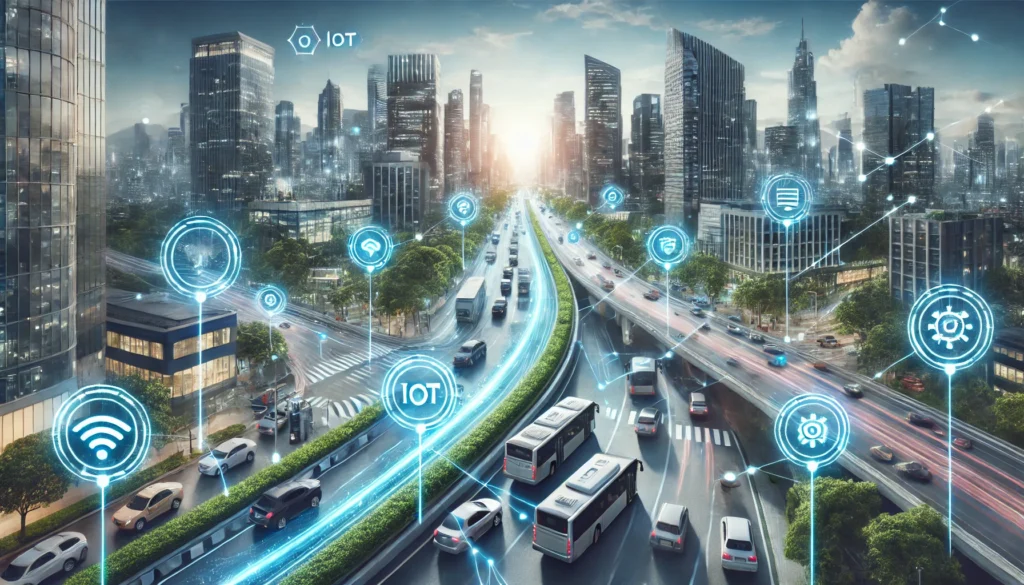
The concept of IoT in Transportation Smart Cities is revolutionizing how urban areas function. By integrating the Internet of Things (IoT) into transportation systems, smart cities aim to create efficient, sustainable, and safe urban environments. This article explores the importance of IoT in transportation, its applications, benefits, and challenges while maintaining readability and adhering to SEO best practices.
Table of Contents
- Introduction to IoT in Transportation Smart Cities
- Key Components of IoT in Transportation
- Applications of IoT in Smart City Transportation
- Smart Traffic Management
- Public Transport Optimization
- Autonomous Vehicles
- Infrastructure Monitoring
- Benefits of IoT in Transportation Smart Cities
- Challenges and Limitations
- Future Trends
- Conclusion
1. Introduction to IoT in Transportation Smart Cities
Smart cities rely heavily on technology to improve the quality of life for their residents. Among the numerous innovations, IoT in Transportation Smart Cities has emerged as a game-changer. IoT enables devices and systems to communicate, analyze data, and make decisions without human intervention. In transportation, this means smarter traffic flow, reduced congestion, and better safety protocols.
The incorporation of IoT allows cities to address pressing issues like pollution, inefficient public transport, and road safety. Furthermore, by embedding IoT sensors into urban infrastructure, data collection becomes seamless, fostering innovation in transportation systems.
2. Key Components of IoT in Transportation
IoT in transportation relies on several critical components that enable its seamless operation:
IoT Sensors and Devices
Sensors are at the heart of IoT systems. They monitor various parameters, including traffic density, vehicle speed, and environmental conditions.
Data Transmission Networks
High-speed networks like 5G ensure data is transmitted in real time between devices and control centers.
Edge and Cloud Computing
IoT systems use edge and cloud computing to process vast amounts of data, enabling instant decision-making.
AI and Machine Learning Integration
Artificial intelligence (AI) and machine learning analyze data patterns to optimize transportation and predict potential issues.
3. Applications of IoT in Smart City Transportation
IoT applications in smart city transportation span multiple areas, each aimed at creating an efficient urban mobility system.
3.1 Smart Traffic Management
One of the primary applications of IoT in transportation is managing traffic more effectively. Sensors and cameras monitor real-time traffic conditions and relay data to central systems. Smart traffic lights adjust their timings based on congestion levels, significantly reducing wait times.
3.2 Public Transport Optimization
IoT enhances public transport systems by providing real-time tracking of buses, trains, and metros. Commuters can access accurate arrival times via mobile apps, improving the overall experience.
3.3 Autonomous Vehicles
IoT technology plays a crucial role in the development of autonomous vehicles. Self-driving cars rely on sensors and networks to navigate safely. This innovation has the potential to reduce accidents and improve road safety.
3.4 Infrastructure Monitoring
IoT sensors embedded in roads, bridges, and tunnels monitor structural health. Early detection of wear and tear ensures timely maintenance, preventing accidents and costly repairs.
4. Benefits of IoT in Transportation Smart Cities
The benefits of IoT in Transportation Smart Cities are transformative, impacting various aspects of urban life.
4.1 Improved Traffic Flow
Smart traffic systems reduce congestion by optimizing traffic signal timings based on real-time data. This leads to shorter travel times and less frustration for drivers.
4.2 Enhanced Safety
IoT devices improve safety by monitoring road conditions and alerting drivers to hazards. Emergency response times are also faster due to real-time incident reporting.
4.3 Environmental Benefits
By optimizing routes and reducing idling times, IoT helps lower fuel consumption and greenhouse gas emissions. Electric vehicle integration further enhances sustainability efforts.
4.4 Cost Efficiency
Cities save money by preventing infrastructure failures and optimizing resource allocation. Public transport systems also operate more efficiently, reducing operational costs.
5. Challenges and Limitations
Despite its potential, implementing IoT in transportation smart cities comes with several challenges:
5.1 Data Privacy and Security
IoT systems collect vast amounts of data, raising concerns about privacy and potential cyberattacks.
5.2 High Initial Costs
Deploying IoT infrastructure requires significant investment, which may be a barrier for some cities.
5.3 Interoperability Issues
Integrating different IoT devices and platforms can be complex due to varying standards and protocols.
5.4 Maintenance and Updates
IoT systems need regular maintenance and updates, which can be resource-intensive.
6. Future Trends
The future of IoT in Transportation Smart Cities looks promising, with innovations set to reshape urban mobility.
6.1 Integration with AI
Artificial intelligence will play a larger role in predictive analytics and real-time decision-making.
6.2 Expansion of 5G Networks
Faster and more reliable networks will enhance IoT system performance.
6.3 Increased Use of Autonomous Vehicles
Autonomous vehicles are expected to become more prevalent, driven by advancements in IoT.
6.4 Smart Public Transport Systems
Public transportation will become more integrated and user-friendly, thanks to IoT innovations.
7. Conclusion
IoT in Transportation Smart Cities represents a pivotal step toward creating efficient, sustainable, and safe urban environments. By leveraging IoT technology, cities can address critical issues such as traffic congestion, environmental sustainability, and infrastructure management. While challenges remain, ongoing advancements in technology and increasing adoption rates suggest a bright future for IoT in urban transportation systems.
The integration of IoT in transportation is not just a technological evolution but a necessary shift for modern cities to thrive. As we move forward, embracing IoT solutions will be key to unlocking the full potential of smart cities.
Read more :
- https://rmm.abyadi.com/iot-smart-farming-for-a-sustainable/
- https://rmm.abyadi.com/iot-enhances-industrial-efficiency-in-smart-factories/
- https://rmm.abyadi.com/iot-trends-shaping-connected-world/